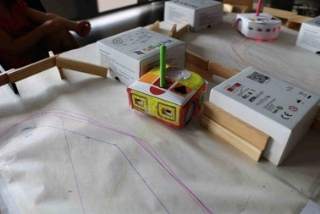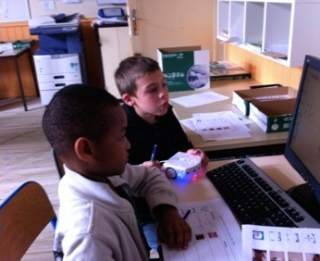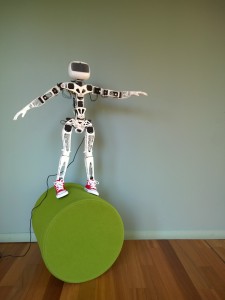Here is the second part of our interview with Didier Roy. To read the first half, it’s over here !
Génération Robots : Why do you think the Thymio 2 has been so successful among children and the Dessine-moi un robot site with teachers and coordinators?
Didier Roy : As far as the Thymio robot is concerned, the team led by its designer, Professor Francesco Mondada from EPFL (École Polytechnique Fédérale de Lausanne), has done a remarkable job. This affordable open source hardware and software robot was designed for education. Everything is arranged intelligently and the numerous sensors and actuators available make it a great choice. Its key feature is that it’s extremely easy to use , just like the visual (Thymio VPL) and textual (Aseba Studio) programming software.
It can be used in primary schools and through to university..

As for the ”
Dessine-moi un robot”
site, I should point out that there are in fact three sites: the core
dessinemoiunrobot.fr
(or dm1r.fr) site, its associated forum
dm1r.inria.fr
and
inirobot.fr
, which points to a part of the previous site dedicated to IniRobot.
These sites all fall under the Dessine-moi un robot banner and propose turnkey activities, reports, links and discussions between users. Their aim is to b
e as useful as possible for those wanting to organise activities
initiating people to robotics.
The activities carried out as part of the Inirobot project are successful today because they are so simple. Carefully developed by a team of researchers and teachers and tested in a real-life context , to create an easy-to-use “missions book”, they bring truly accessible projects to life. The documents for download contain proposals for activities, associated files and corrections, and all content is Creative Commons open source so it can be adapted by each user.
The
ready-to-use aspect
is important for its distribution, because not everyone has the time to create their own robotics activities.
The only thing we ask for in exchange is some
feedback on the dm1r.inria.fr forum
, so the community as a whole can benefit from individual experiences.
Génération Robots : This is all a far cry from the kind of technology classes given 15 to 20 years ago, and the government is showing its strong determination to place a special focus on digital technology and on innovative technological training in schools. How do you think technological studies will evolve in the future?
Didier Roy : And teaching in general! I’m sure (and I hope) we are moving towards a mainly cooperative form of education where students work in small groups around judiciously selected projects.

The teacher will still play a key role
, to ensure the scientific rigour of what is proposed, to manage discussions and to assist with learning. A more rewarding education for everyone, both children and adults, based not only on knowledge but also on creativity and initiative.
And, why not, a more cross-disciplinary form of teaching, where groups sharing the same skills are formed in addition to those created by age group , taking people’s differences into account to enrich the learning process, and using digital technologies to help customise training programs.
Génération Robots : More and more people believe that democratising digital technology in schools could prevent pupils from dropping out. Why is this do you think?
Didier Roy :
Let’s say it could help prevent this, to be on the safe side.
Digital technology offers advantages because it can be used to differentiate training, through exercisers, learning games and educational support platforms, especially as today we know how to optimise and customise these tools using machine learning algorithms (take for example the
Kidlearn project
,).
It can also be used as a means to help visualise situations, simulate environments, find information and facilitate interaction.
These two aspects – learning optimisation and personalisation –
make it a fundamental tool in the fight against academic failure and for equal opportunities.
Digital tools are a natural progression of our technological society and as such have their rightful place in education, since they offer something more. Which does not mean, and I strongly believe this, that we need to throw away everything that already exists and works well.
Let’s take this opportunity to distinguish between two aspects of “digital technology”, which is a catch-all used to describe anything we want. There are digital tools, like those I’ve just mentioned, and digital sciences, which must be taught to make sure everyone understands today’s world – not necessarily how their robotised washing machine works (!), but computer and robotics thinking, which is gradually redefining our society.
Génération Robots : Poppy, the Flowers research team’s latest project, is the first humanoid robot in the world to be both open source and 3D printed. How is this robot received in schools and research centres? How do you see Poppy’s future in schools?
Didier Roy : We’ve already touched on this subject. P oppy is a platform created for research, to help study development mechanisms in humans and by analogy in robots (the Flowers team ’s field of research, social and developmental robotics). In this particular case, we are studying locomotion. Which is why Poppy walks like a child if held by the hand.
It turns out that it’s a perfect platform for education, due notably to the fact that it’s open source. The main themes are mechatronics and informatics, but there are others too. Poppy is also used for artistic performances.

Its target audience is pupils reaching the end of secondary school and higher education students. Several universities and engineering schools are today buying Poppy kits or building their own Poppy robots themselves, sometimes only an arm or a bust, depending on their needs and budgets.
A community has formed and is gradually growing
, ensuring the platform will evolve and be used in more different ways, for a wider range of experiences.
And don’t forget the Poppy Mini, which costs less (15 times less expensive, around 500 euros) so it will have its own place in this market, less impressive than its big brother but much more affordable.
Génération Robots : A final word?
Didier Roy :
I find using research to create new tools for educating people about digital sciences extremely exciting.
By imagining uses conducive to learning, we’re helping, albeit modestly, to
prevent pupils from dropping out of school and equal opportunities
. More and more researchers and teachers, interested in what digital sciences can do to help, are becoming involved in such activities. It’s very encouraging.
I wouldn’t dare go so far as to say we want to make the world a bit easier for everyone to understand , a little less unequal, because that sounds presumptuous, but there is some truth in that.

